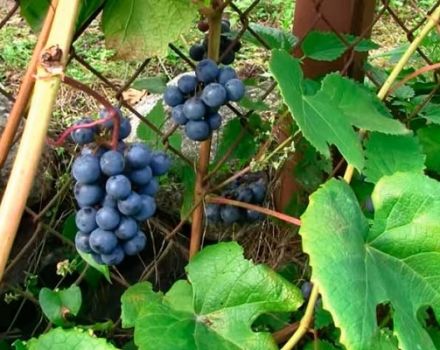Description and characteristics of Victor grapes, pros and cons, cultivation
The famous and popular grape variety is Victor. It turned out thanks to the amateur work of a famous breeder. The result of the activity is a beautiful appearance and commercial quality of berries. Victor grapes are used to grow fruits for sale and in households. Victor is considered the best among the fast ripening varieties.
Breeding history
This grape variety was developed by amateur V.N. Krainov, who lives in the city of Novocherkassk. In the environment he was called "a private breeder." In fact, he did not work in educational institutions or special laboratories, he created new varieties of plants in his favorite garden. The amateur began to develop new types of grapes since 1995.

The name of V.N. Krainova is immortalized in his varieties Victor and Victor-2. The scientist received new species thanks to the crossing of the Talisman and Kishmish Radiant varieties. As a result, the Victor variety was obtained. Victor-2 is similar in appearance, its second name is Sympathy.
Description of grapes Victor
In order to understand what a shrub looks like, you need to consider its description in detail:
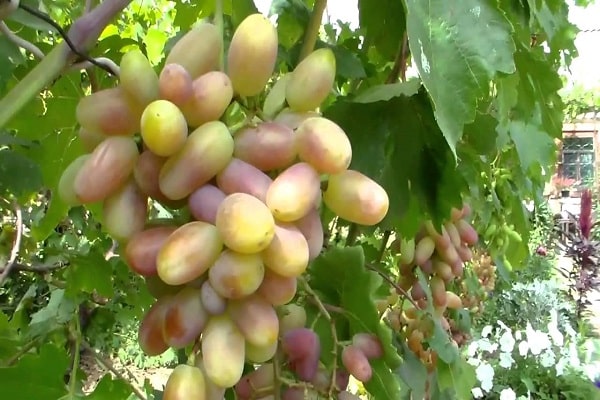
- Pollinated with bisexual flowers.
- Forms stepchildren, on which the harvest appears.
- The vine ripens by 2/3. This phenomenon is considered beneficial.
Fruiting depends on proper care of the shrub.
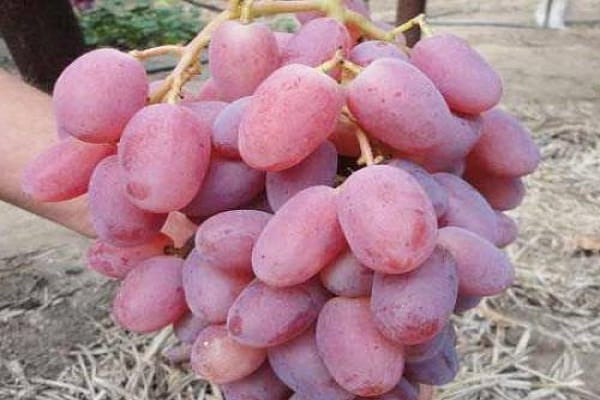
Variety characteristics
The grapes are large, conical in shape. I would like to pay special attention to the characteristics of berries in order to understand all the uniqueness of grapes:
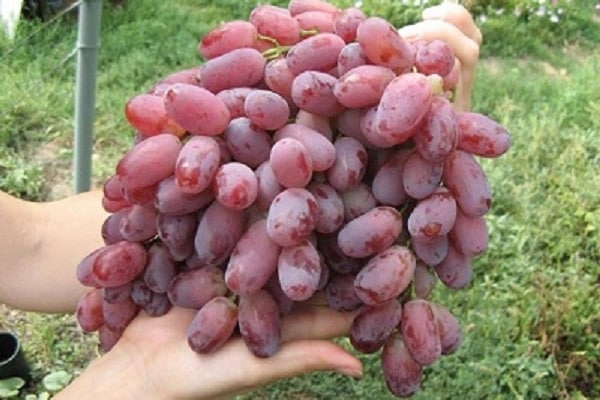
- the weight of a medium-sized bunch of grapes varies from 0.5 to 1 kilogram;
- when harvesting, 6-8 kilograms of juicy, tasty grapes are removed from one bush;
- no pea fruit. The berries are large in size, each weighing from 15 to 19 grams. The shape is oval, with a slightly pointed end. In appearance, this variety can be confused with Ladies' fingers;
- the size of the berries can be from 3.5 to 6 centimeters;
- bones develop inside each fruit, but there are very few of them (1-2 pieces);
- the color of the grapes depends on the time spent in direct sunlight: pink, dark red, purple;
- taste at altitude. The pulp is fleshy and rich, the skin is thin (not felt during use);
- the presence of sugar - 17%, acid - up to 8 g / l.

Pros and cons
The advantages of the variety are distinguished:
- No peeling.
- Stable, regular fruiting.
- Ripening of the vine occurs at 2/3.
- Harvesting is possible early.
- The rooting of cuttings is good, adaptation to climatic conditions is fast.
- Able to survive in low temperatures. Withstands frosts down to -23 degrees.
The negative aspects of the variety include:
- attractiveness to insects in the early flowering time;
- the risk of damage to the ovary by late frosts increases.
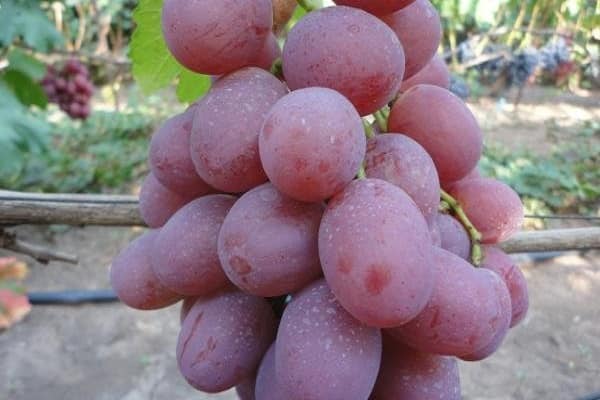
Landing features
Planting seedlings in the ground is carried out in the 3rd decade of April. There is no snow at this time. The site must be chosen on the sunny side, without cold wind and drafts. It is worth remembering that an adult shrub needs a plot with an area of at least 6 square meters. It is worth leaving 5 meters of free land between the seedlings.
Uplands, hills are considered favorable places. Cold air is not retained in such places.
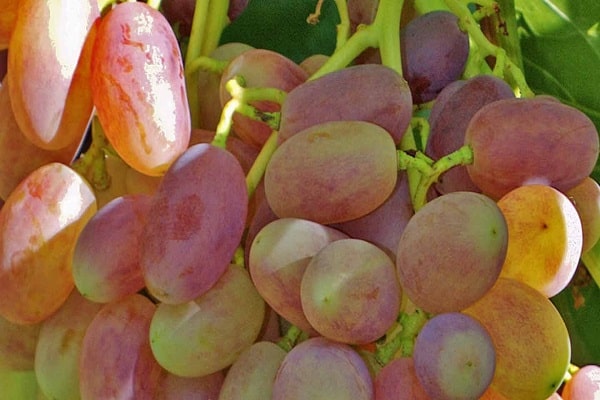
The soil should be light, well permeable to liquid, not swampy. Excessive moisture adversely affects the root system of grapes.
Consider the step-by-step steps for the correct planting of a seedling:
- Dig a hole 20 days before the expected planting of the bush. This is required in order for the earth to settle. Size: 80 * 80 * 80 centimeters.
- Add organic fertilizers to 1/3, and add potassium salt, nitrogen and superphosphate. Cover the hole with ordinary earth about 10 centimeters on top. This action will help to avoid burning the root system, and at the same time the seedling will receive nutrients from the soil in a timely manner.
- Plant a shrub so as not to deepen the root collar. Trample the soil. Water abundantly and mulch with sawdust or moss, for a longer moisture retention.
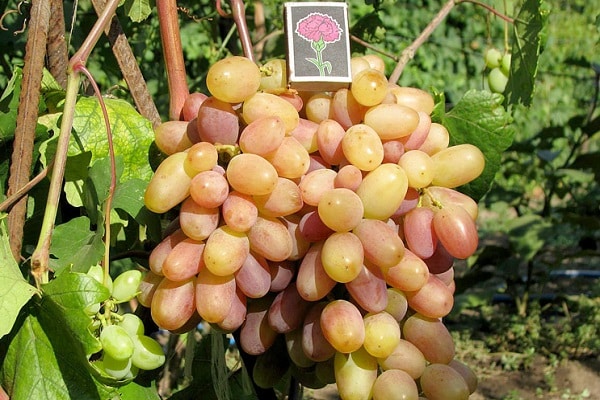
Care Tips
In order for Victor grapes to grow and bear fruit, it is important to properly care for:
- pruning. When the vine is still small, it is recommended to pinch it in order to properly form the shrub. Once it has grown to 170 centimeters, pinch it. Regular pruning of excess shoots will help increase yield. For quick ripening of fruits, it is worth cutting off the leaves around the bunches, so that more sunlight will fall on them. Pruning a fruiting vine is made short (remove 4 eyes) or long (up to 10 eyes). It is not recommended to overload the plant strongly, otherwise the shrub will not be able to bear fruit;
- feeding is recommended in the first half of summer, and preferably several times. Fertilizer can be bought in a specialized store or made on your own at home. In the latter case, in a capacious container, it is required to combine the following components: wood ash (50 grams), water (10 liters), cow dung (2 kilograms), superphosphate (30 grams). Stir - the fertilizer is ready. Recommended to fertilize after harvest;
- watering is carried out in a timely manner and abundantly. Excessive moisture or drying out of the soil should be avoided. Foliage, moss, spruce branches will help maintain soil moisture.
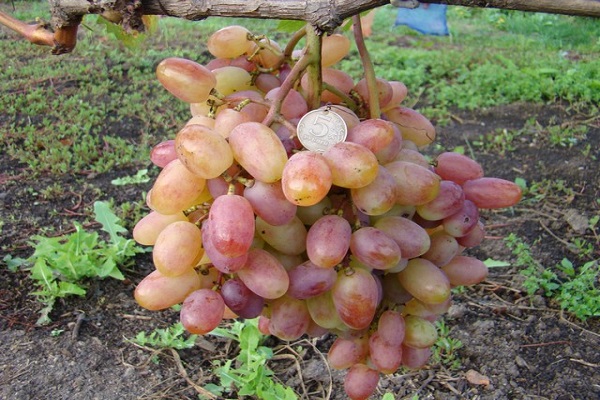
Breeding varieties
Victor grapes are propagated in 4 ways:
- Saplings.
- By grafting cuttings.
- Layers.
- With bones.
Regardless of the method chosen, the grapes take root well, retaining their properties. When grafting with cuttings, it is worth remembering that as a result, a hybrid plant can be obtained, in which the properties of the mother bush and Victor's grapes are preserved. When using the seeds, you need to be patient, since it will take a lot of time for the first berries to appear on the bush.
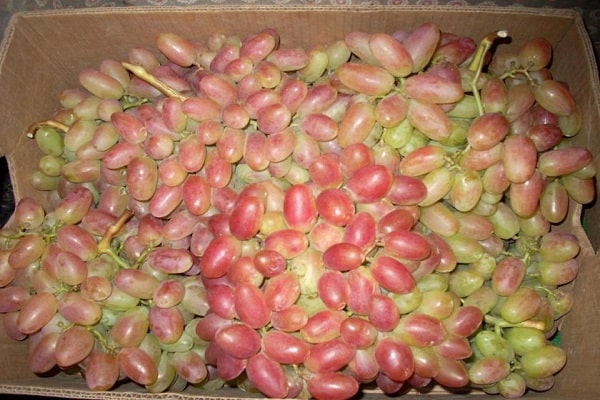
Diseases and pests
Grape Victor has resistance to fungal, pathogenic microorganisms. Despite this, the bushes need to be processed and protected.
Processing is carried out before flowering and during the formation of berries.









